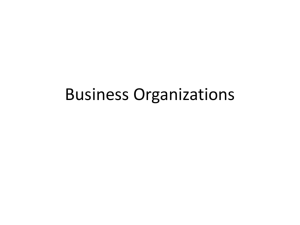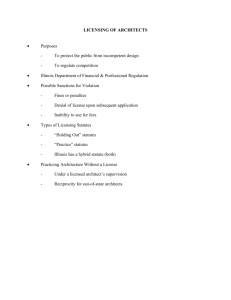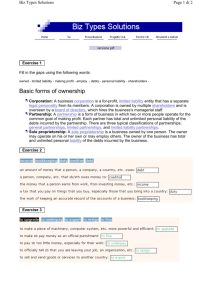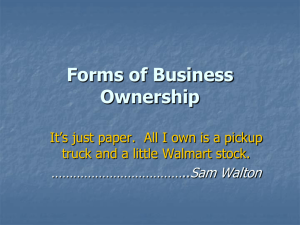Business Organization
advertisement
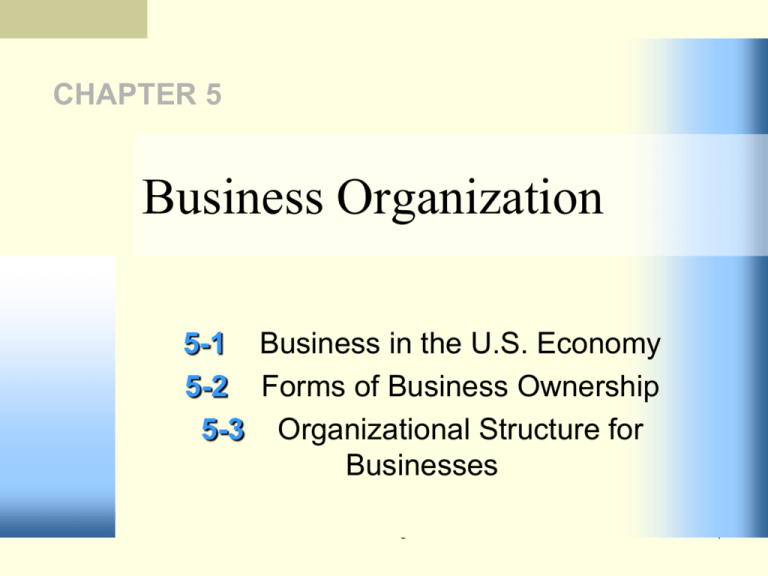
CHAPTER 5 Business Organization 5-1 Business in the U.S. Economy 5-2 Forms of Business Ownership 5-3 Organizational Structure for Businesses 5 1 5-1 Business in the U.S. Economy Goals 38. Describe the changing status of U.S. employment 39. Discuss the role of business in the U.S. economy 40. Describe the three major types of businesses 5 2 Key Terms contingent worker producer intermediary service business 5 3 38. THE CHANGING U.S. JOB MARKET Employment data Pressures on employees 5 4 Checkpoint >> List several groups that will increase as a percentage of the total U.S. workforce in the next decade. Answer Younger workers (16–24 years of age) Asian-, Hispanic-, African-American groups Women 5 5 39. BUSINESS AND THE ECONOMY Size of businesses Roles of business Impact on a community 5 6 Percent of Businesses by Employee Size Source: U.S. Census Bureau 5 7 39. (continued) BUSINESS ACTIVITIES Generating ideas Raising capital Employing and training personnel Buying goods and services Marketing goods and services Maintaining business records 5 8 Checkpoint >> What are the basic activities completed by all businesses? Answer are generating ideas raising capital employing and training personnel buying goods and services marketing goods and services maintaining business records 5 9 40. TYPES OF BUSINESSES Producers Intermediaries Service businesses 5 10 Checkpoint >> How does a manufacturer differ from an extractor? Answer An extractor takes natural resources, such as oil or timber, for direct consumption or for use in developing other products. A manufacturer takes resources supplied by others and converts them into useable products. 5 11 5-2 Forms of Business Ownership Goals 41. Understand the three major forms of business ownership 42. Determine when each form of business ownership is most appropriate 43. Recognize other specialized business ownership forms 5 12 Key Terms proprietorship partnership corporation partnership agreement articles of incorporation franchise 5 13 41. BUSINESS OWNERSHIP Proprietorship~ Business owned and run by just one person (Unlimited Liability) Partnership~ Business owned and controlled by two or more people (Unlimited Liability) Corporation~ Separate legal entity formed by documents filed with a state. Owned by one or more shareholders and managed by a board of directors (Limited Liability) 5 14 Source: Internal Revenue Service Forms of Ownership 5 15 Checkpoint >> What are the differences between the three main forms of business ownership? Answer Business forms differ in the ways in which decision-making and investments are made and to whom liabilities are distributed. 5 16 CHOOSING A FORM OF BUSINESS OWNERSHIP Choosing a proprietorship~ Most businesses begin this way and remain this way Total control is with the owner Easy to begin- only requires gov’t licenses and/or permits Tax advantage/disadvantage ALL income is part of business and expenses can often be written off to reduce income ALL debts are owner’s responsibility (Unlimited liability) 5 17 42. CHOOSING A FORM OF BUSINESS OWNERSHIP (continued) Choosing a partnership~ Can sometimes be formed by verbal agreement BUT most of the time, a written partnership agreement is prepared Details the rules and procedures that guide ownership and operations Lists clearly the business name, investments, and partner contributions Shows how profits and losses will be divided among partners Defines authority and responsibilities granted to each partner States how the partnership can be dissolved 5 18 Partnership (continued Advantages More people contribute to the investment in the business More expertise Disadvantages Each partner is responsible for the decisions of all other partners No protection of personal assets of each partner Unlimited Liability 5 19 CHOOSING A FORM OF BUSINESS OWNERSHIP (42. continued) Choosing a corporation~ Not just an option for large businesses Increasing in popularity of small businesses as well Subject to many more laws and are more difficult to form 5 20 Corporations (continued) Treated as an “individual” by gov’t Must obey laws of the state and must file ‘articles of incorporation’ Written legal document that defines ownership and operating procedures (corporate bylaws) and conditions A Board of Directors must be appointed Must issue shares of stock to investors 5 21 Corporation (continued) Advantages~ Liability is limited to the amount of money invested Amount of debt of the business does not matter People can invest in the business and receive part of the profits without having to take part in the day-to-day operations Can be easily expanded 5 22 Corporation (continued) Disadvantages~ Decision-making is shared among managers, board of directors, and shareholders Many records are required and more laws regulate corporations than the other two forms of business ownership Business pays corporate taxes to the government AND investors also pay taxes on individual earnings from the business 5 23 Checkpoint >> Which form of business ownership is the most complex and difficult to form? Answer The corporation is more complex to begin than other business forms. Forming a corporation requires much more bureaucracy, is more subject to government regulations, requires the organization of a board, and must have clearly defined bylaws. 5 24 43. OTHER FORMS OF OWNERSHIP Specialized partnerships and corporations Limited liability partnership http://legal-dictionary.thefreedictionary.com/Limited+Liability+Partnership Identifies some investors who cannot lose more than they have invested, BUT they are not permitted to participate in the day-to-day management of the business Joint Venture Unique business organized by 2 or more businesses to operate for a limited time for a specific project 5 25 43. OTHER FORMS OF BUSINESS OWNERSHIP (continued) Specialized partnerships and corporations (continued) S-Corporation http://www.irs.gov/businesses/small/article/0,,id=98263,00.html For small businesses Offers the limited liability of a corporation All income is passed through to the owners based on their investment and is taxed on individual earnings Limited Liability Company (LLC) http://www.irs.gov/businesses/small/article/0,,id=98277,00.html Newer form of ownership Combines partnership with corporation Provides liability protection for owners Simpler than a corporation No articles or bylaws are needed 5 26 43. OTHER FORMS OF BUSINESS OWNERSHIP (continued) Specialized partnerships and corporations (continued) Nonprofit corporation Joined to do something that benefits the public Education, health care, charity, the arts… Free from corporate income taxes Receive grants and donations from individuals and businesses Must meet government requirements 5 27 43. OTHER FORMS OF BUSINESS OWNERSHIP (continued) Cooperatives Cooperative~ Owned by members and serves their needs Two types: Consumers Cooperatives Business (Producer’s) Cooperatives http://www.youngzine.com/article/2012- international-year-cooperatives 5 28 43. OTHER FORMS OF BUSINESS OWNERSHIP (continued) Franchises http://www.redhotfranchises.com/ Written contract granting permission to operate a business to sell products and services in a set way. Franchiser- company that owns the product or service and grants the right to another business Franchisee- company that purchases the rights to run the business Franchisee maintains day-to-day operations and receives profits Pays fees and percentage of profits to franchiser 5 29 Checkpoint >> What are the other specialized forms of business ownership? Answer limited liability partnership joint venture S-corporation limited liability companies (LLC) nonprofit corporations. franchise cooperative 5 30 Mini-Project Find and list five franchises that interest you using www.redhotfranchise.com 5 pts For each franchise, answer the following questions: 25 pts How much liquid capital is needed to purchase the franchise? Is training from the parent company provided? Provide a brief description of the franchise (what the business does, their goals, mission, competitive edge, and other activities, etc.). 30 pts total 5 31 5-3 Organizational Structure for Businesses Goals 44. Understand important principles in designing an effective organization 45. Compare alternative organizational structures for businesses 5 32 Key Terms (continued) Organization chart~ Diagram that shows the structure of an organization, classifications of work/jobs, and relationships among those classifications 5 33 Business Organization Chart 5 34 45. TYPES OF ORGANIZATIONAL STRUCTURES Functional organization structure Work is arranged within main business functions such as production, operations, marketing, and human resources All people with related jobs work together Advantages and Drawbacks Matrix organizational structure Work is structured around specific projects, products, or customer groups People with varied backgrounds are assigned together because their expertise is required for the project or to serve a customer 5 Groups may be temporary or long-term 35 44. DESIGNING AN EFFECTIVE BUSINESS ORGANIZATION Setting direction Mission Statement, Goals, Policies, and Procedures Principles of effective organization Responsibility, Authority, Accountability, Unity of Command, and Span of Control 5 36 Setting Direction (Obj. 44 continued) Mission statement~ Short, specific written statement of the reason a business exists and what it wants to achieve. Goal~ A precise statement of results the business expects to achieve Used to define what needs to be accomplished Policies~ Guidelines used in making consistent decisions Procedures~ Descriptions of the way work is to be done 5 37 Principles of Effective Organization (Obj. 44 continued) Responsibility (obligation to complete specific work), Authority (right to make decisions about how responsibilities should be accomplished), and Accountability (taking responsibility for the results achieved) Unity of command (clear reporting relationship for all staff of a business~ ‘chain of command) Span of control (the number of employees who are assigned to a particular work task and manager) 5 38 Checkpoint >> What is the difference between a mission statement and a goal? Answer A mission statement states the purpose of existence for a business and what it hopes to achieve. A goal is a more specific statement of what a business expects to achieve and may be used to measure a business’ success. 5 39 Checkpoint >> What problems can result from the use of a functional organizational structure? Answer Employees in a functional organizational structure may tend to loose sight of overall corporate goals. Workers tend to be limited to specific duties and may not see their relationship to the organization as a whole. This can result in lack of interest and motivation over time. 5 40 Chapter 5-3 and Review Page 118 1-3 and Choose 4 or 5 Pages 120-123 1-23 and Choose 1 from 24-31 5 41



